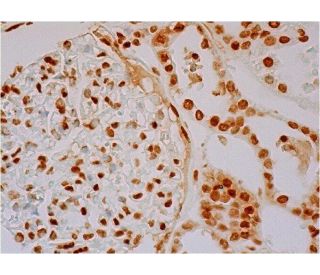



Anticorps Pax-3/7 (E-10): sc-365613
- L'Anticorps Pax-3/7 (E-10) est un monoclonal de souris IgG1 κ, cité dans 3 publications, fourni en 200 µg/ml
- spécifique d'un épitope situé entre les acides aminés 439-464 au niveau C-terminus de Pax-3 d'origine human
- recommandé pour la détection de Pax-3 and Pax-7 d'origine mouse, rat, human et avian par WB, IP, IF, IHC(P) et ELISA; également réactif avec d'autres espèces, dont et equine, bovine, porcine and avian
- Réactifs TransCruz pour une application en ChIP (sc-365613 X, 200 µg/0.1 ml)
- Voir Pax-3/7 (B-5): sc-365843 pour d'autres anticorps conjugués Pax-3/7, dont AC, HRP, FITC, PE, Alexa Fluor® 488, 594, 647, 680 et 790.
- m-IgG Fc BP-HRP et m-IgG1 BP-HRP sont les réactifs secondaires recommandés pour la détection de l'anticorps Pax-3/7 (E-10) pour des applications de WB and IHC(P). Ces réactifs sont maintenant proposés en kit avec l'anticorps Pax-3/7 (E-10) (voir Informations pour la commande ci-dessous).
Pax genes contain paired domains that share strong homology to genes in Drosophila which are involved in programming early development. The product of the Pax-3 gene is a DNA-binding protein expressed during early neurogenesis. Pax-3 is a protein containing both a paired domain and a paired-type homeodomain. During early neurogenesis, Pax-3 expression is limited to mitotic cells in the ventricular zone of the developing spinal cord and to distinct regions in the hindbrain, midbrain and diencephalon. In 10-12 day embryos, expression of Pax-3 is also seen in neural crest cells of the developing spinal ganglia, the craniofacial mesectoderm and in limb mesenchyme. Mutations in the MITF and Pax-3 genes, encoding transcriptions factors, are responsible for Waardenburg syndrome II (WS2) and WS1/WS3, respectively. Pax-7 is a gene specifically expressed in cultured satellite cell-derived myoblasts. In situ hybridization revealed that Pax-7 is also expressed in satellite cells residing in adult muscle. The gene which encodes Pax-7 maps to human chromosome 1p36.2-p36.12.
Informations pour la commande
| Nom du produit | Ref. Catalogue | COND. | Prix HT | QTÉ | Favoris | |
Anticorps Pax-3/7 (E-10) | sc-365613 | 200 µg/ml | RMB2377.00 | |||
Pax-3/7 (E-10): m-IgG Fc BP-HRP Kit | sc-540353 | 200 µg Ab; 10 µg BP | RMB2662.00 | |||
Pax-3/7 (E-10): m-IgG1 BP-HRP Kit | sc-542060 | 200 µg Ab; 20 µg BP | RMB2662.00 | |||
Pax-3/7 (E-10) peptide neutralisant | sc-365613 P | 100 µg/0.5 ml | RMB511.00 | |||
Anticorps Pax-3/7 (E-10) X | sc-365613 X | 200 µg/0.1 ml | RMB2377.00 |
